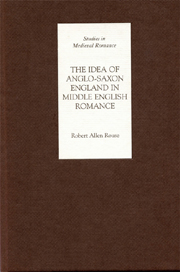Book contents
- Frontmatter
- Contents
- Miscellaneous Frontmatter
- Acknowledgments
- 1 Anglo-Saxonism: The Remembrance and Re-Imagining of the Anglo-Saxon Past
- 2 Remembering Alfred in the Twelfth Century
- 3 The Romance of the Anglo-Saxon Past
- 4 The Romance of English Identity
- 5 In his time were gode lawes: Romance and the English Legal Past
- 6 Literary Terrains and Textual Landscapes: The Importance of the Anglo-Saxon Past in Late-Medieval Winchester
- Conclusion
- Bibliography
- Index
1 - Anglo-Saxonism: The Remembrance and Re-Imagining of the Anglo-Saxon Past
Published online by Cambridge University Press: 12 September 2012
- Frontmatter
- Contents
- Miscellaneous Frontmatter
- Acknowledgments
- 1 Anglo-Saxonism: The Remembrance and Re-Imagining of the Anglo-Saxon Past
- 2 Remembering Alfred in the Twelfth Century
- 3 The Romance of the Anglo-Saxon Past
- 4 The Romance of English Identity
- 5 In his time were gode lawes: Romance and the English Legal Past
- 6 Literary Terrains and Textual Landscapes: The Importance of the Anglo-Saxon Past in Late-Medieval Winchester
- Conclusion
- Bibliography
- Index
Summary
THE Norman Conquest brought about the assimilation of England into the burgeoning Norman Empire and the destruction of a ruling elite, producing what some scholars have viewed as a cultural watershed. John Gillingham has written that ‘the devastating experience of 1066 had meant that the correspondence between a kingdom and a people, a community of tradition, custom, law and descent … no longer applied in England’. The extent to which this ‘community of tradition, custom, law and descent’ was displaced under Norman rule is a much-debated issue, but the conquest is generally agreed to have been the end of what we now call Anglo-Saxon England. This is not to say, however, that Anglo-Saxon England ceased to be vital as a cultural construct in post-conquest England. The remembrance and re-imagining of Anglo-Saxon England in the post-conquest period is part of an ongoing cultural process that began from the first moment that William stood among the slain Anglo-Saxon nobles after the battle of Hastings.
The focus of this study is the remembrance of Anglo-Saxon England in the literature of post-conquest England and its appropriation for various social and ideological purposes. In the post-conquest representation of the pre-conquest English past the Anglo-Saxon era is characterised by two distinct periods: the period of the arrival of the pagan Saxons, and the period of the Christianised Anglo-Saxon kingdoms. This study is concerned with the representation of the later period.
- Type
- Chapter
- Information
- Publisher: Boydell & BrewerPrint publication year: 2005



